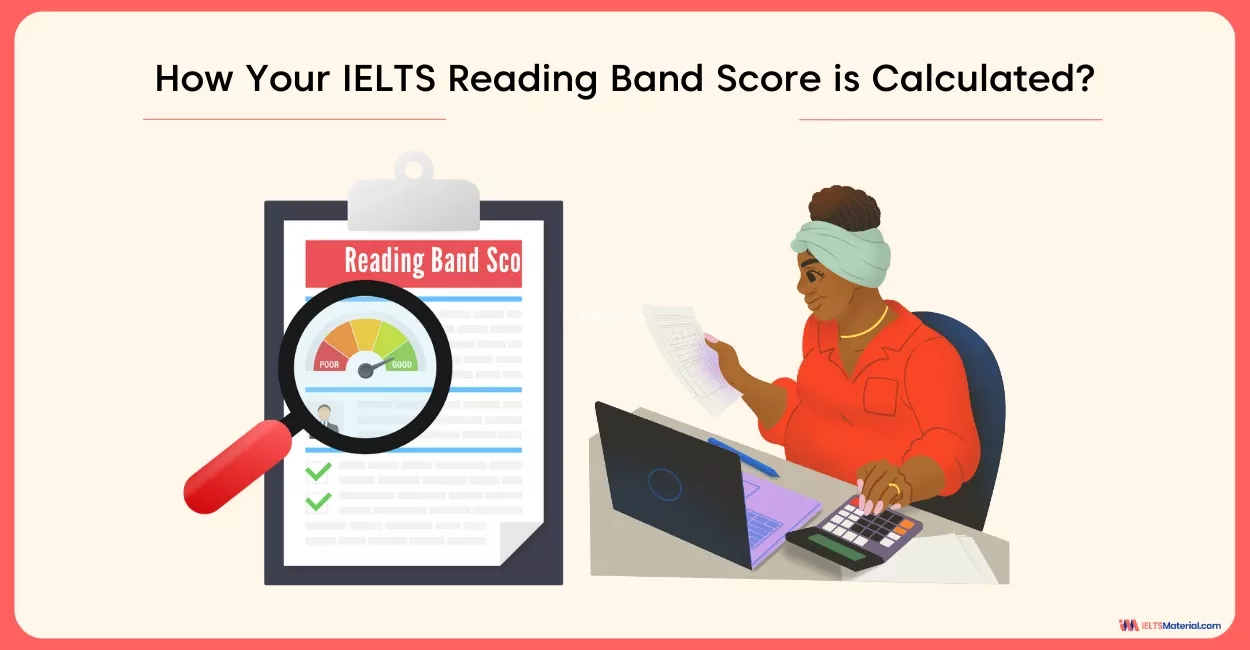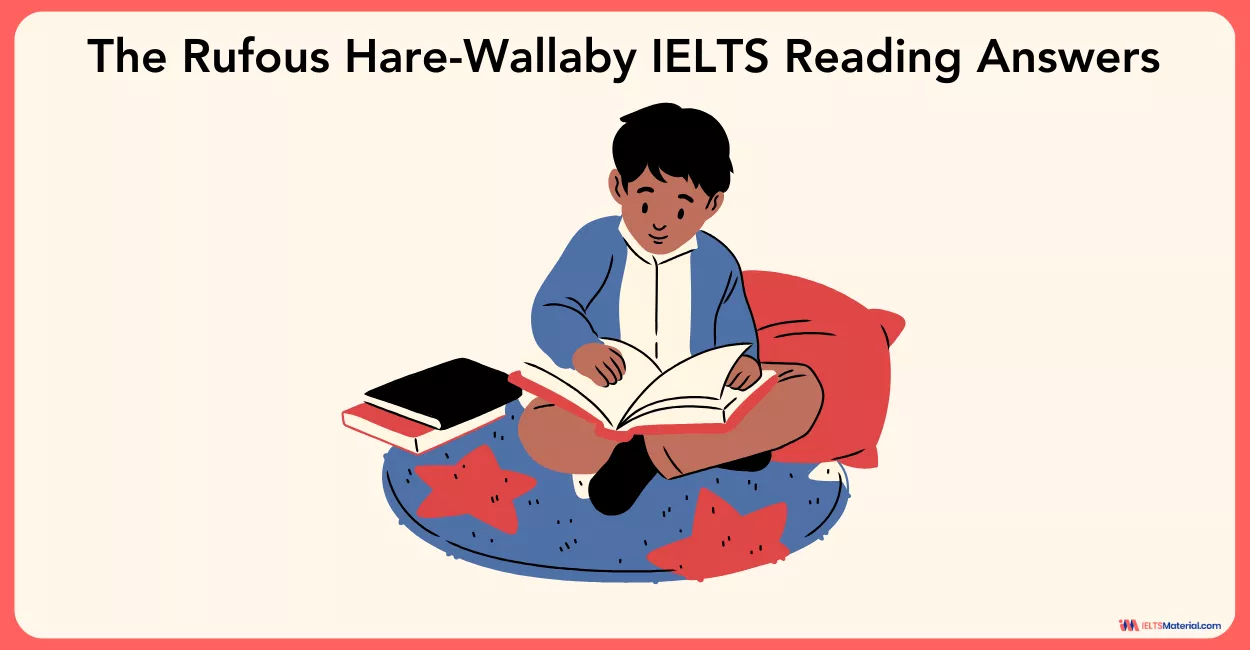The Rufous Hare-Wallaby IELTS Reading Answers
8 min read
Updated On
-
Copy link
The Academic passage ‘The Rufous Hare-Wallaby’ appeared in an IELTS Reading test. This blog provides complete answers with detailed explanations, exact answer locations, and expert tips to help you confidently tackle every IELTS Reading question type.
Table of Contents

Limited-Time Offer : Access a FREE 10-Day IELTS Study Plan!
The Academic passage ‘The Rufous Hare-Wallaby’ is a challenging IELTS Reading passage that appeared in the test, designed to assess your comprehension and analytical skills. In this blog, you’ll find the complete IELTS Reading answers with detailed explanations, exact answer locations in the passage, and step-by-step reasoning. We also provide expert IELTS Reading tips and strategies to help you confidently tackle every question type and improve your overall band score.
The Rufous Hare-Wallaby IELTS Reading Passage
You should spend about 20 minutes on Questions 1 - 13, which are based on the Reading Passage below.
The Rufous Hare-Wallaby is a species of Australian kangaroo, usually known by its Aboriginal name, ‘mala’. At one time, there may have been as many as ten million of these little animals across the arid and semi-arid landscape of Australia, but their populations, like those of so many other small endemic species, were devastated when cats and foxes were introduced – indeed, during the 1950s it was thought that the mala was extinct. But in 1964, a small colony was found 450 miles northwest of Alice Springs in the Tanami Desert. And 12 years later, a second small colony was found nearby. Very extensive surveys were made throughout historical mala range – but no other traces were found.
Throughout the 1970s and 1980s, scientists from the Parks and Wildlife Commission of the Northern Territory monitored these two populations. At first it seemed that they were holding their own. Then in late 1987, every one of the individuals of the second and smaller of the wild colonies was killed. From examination of the tracks in the sand, it seemed that just one single fox had been responsible. And then, in October 1991, a wild-fire destroyed the entire area occupied by the remaining colony. Thus the mala was finally pronounced extinct in the wild.
Fortunately, ten years earlier, seven individuals had been captured, and had become the founders of a captive breeding programme at the Arid Zone Research Institute in Alice Springs; and that group had thrived. Part of this success is due to the fact that the female can breed when she is just five months old and can produce up to three young a year. Like other kangaroo species, the mother carries her young – known as a joey – in her pouch for about 15 weeks, and she can have more than one joey at the same time.
In the early 1980s, there were enough mala in the captive population to make it feasible to start a reintroduction programme. But first it was necessary to discuss this with the leaders of the Yapa people. Traditionally, the mala had been an important animal in their culture, with strong medicinal powers for old people. It had also been an important food source, and there were concerns that any mala returned to the wild would be killed for the pot. And so, in 1980, a group of key Yapa men was invited to visit the proposed reintroduction area. The skills and knowledge of the Yapa would play a significant and enduring role in this and all other mala projects.
With the help of the local Yapa, an electric fence was erected around 250 acres of suitable habitat, about 300 miles’ northwest of Alice Springs so that the mala could adapt while protected from predators. By 1992, there were about 150 mala in their enclosure, which became known as the Mala Paddock. However, all attempts to reintroduce mala from the paddocks into the unfenced wild were unsuccessful, so in the end the reintroduction programme was abandoned. The team now faced a situation where mala could be bred, but not released into the wild again.
Thus, in 1993, a Mala Recovery Team was established to boost mala numbers, and goals for a new programme were set: the team concentrated on finding suitable predator-free or predator-controlled conservation sites within the mala’s known range. Finally, in March 1999, twelve adult females, eight adult males, and eight joeys were transferred from the Mala Paddock to Dryandra Woodland in Western Australia. Then, a few months later, a second group was transferred to Trimouille, an island off the coast of western Australia. First, it had been necessary to rid the island of rats and cats – a task that had taken two years of hard work.
Six weeks after their release into this conservation site, a team returned to the island to find out how things were going. Each of the malas had been fitted with a radio collar that transmits for about 14 months, after which it falls off. The team was able to locate 29 out of the 30 transmitters – only one came from the collar of a mala that had died of unknown causes. So far the recovery programme had gone even better than expected. Today, there are many signs suggesting that the mala population on the island is continuing to do well.
Want to improve your IELTS Academic Reading score? Grab Our IELTS Reading Ebook Today!
The Rufous Hare-Wallaby IELTS Reading Questions
Questions 1-5
Complete the flow chart below.
Choose NO MORE THAN THREE WORDS AND/OR A NUMBER from the passage for each answer.
The Wild Australian mala
• Distant past: total population of up to (1)……………………..in desert and semi-desert regions
• Populations of malas were destroyed by (2)…………………….
• 1964/1976: two surviving colonies were discovered
• Scientists (3)……………………….the colonies
• 1987: one of the colonies was completely destroyed
• 1991: the other colony was destroyed by (4)………………………
• The wild mala was declared (5)………………..
Questions 6-9
Answer the questions below.
Choose NO MORE THAN THREE WORDS AND/OR A NUMBER from the passage for each answer.
6. At what age can female malas start breeding?
7. For about how long do young malas stay inside their mother’s pouch?
8. Apart from being a food source, what value did malas have for the Yapa people?
9. What was the Yapa’s lasting contribution to the mala reintroduction programme?
Questions 10-13
Do the following statements agree with the information given in Reading Passage 1?
WriteTRUE if the statement agrees with the information
FALSE if the statement contradicts the information
NOT GIVEN If there is no information on this
10. Natural defences were sufficient to protect the area called Mala Paddock.
11. Scientists eventually gave up their efforts to release captive mala into the unprotected wild.
12. The mala population which was transferred to Dryandra Woodland quickly increased in size.
13. Scientists were satisfied with the initial results of the recovery programme.
Want to boost your IELTS score? Enroll in our expert-led IELTS online classes today!
The Rufous Hare-Wallaby IELTS Reading Answer with Explanation
Let’s now review the answers to the questions from the passage in the reading section, The Rufous Hare-Wallaby IELTS Reading Answers, and assess your improvement for a high IELTS Reading band score.
| Question Number | Answer | Keywords | Locations of Keywords |
|---|---|---|---|
| 1 | ten million | there may have been as many as ten million | Para 1, line 2 |
| 2 | cats and foxes | devastated when cats and foxes were introduced | Para 1, line 4 |
| 3 | monitored | Commission, Northern Territory monitored these two populations | Para 2, first 2 lines |
| 4 | fire | October 1991, wild-fire destroyed, entire area, remaining colony | Para 2, last 2 lines |
| 5 | extinct | mala was finally pronounced extinct in the wild | Para 2,, last line |
| 6 | 5 months | female can breed when she is just five months old | Para 3, lines 3-4 |
| 7 | 15 weeks | in her pouch for about 15 weeks | Para 3, line 5 |
| 8 | (strong) medicinal powers | strong medicinal powers for old people | Para 4, lines 3-4 |
| 9 | skills and knowledge | skills, knowledge, would play, significant and enduring role | Para 4, last 2 lines |
| 10 | FALSE | unfenced wild | Para 5, line 5 |
| 11 | TRUE | reintroduction programme was abandoned | Para 5, line 5 |
| 12 | NOT GIVEN | ||
| 13 | TRUE | recovery programme, better than expected | Para 7, line 5 |
Practice with the IELTS Reading Recent Actual Tests to improve your accuracy using real exam questions and answers!
Tips for Answering the Question Types in The Rufous Hare-Wallaby IELTS Reading Answers
Let us check out some quick IELTS Exam Preparation Tips for Band Score of 8+ to answer the three types of questions in the Reading Answers.
Flow Chart Completion in IELTS Reading
Flow chart completion questions test your ability to understand sequences and processes. You need to identify how information flows and match it with the passage accurately. Here are 5 Tips for Flow Chart Completion:
- Skim the Passage for Process Stages – Look for sequence markers like first, then, after, finally to map the flow.
- Check Word Limit Carefully – Always follow the instructions (e.g., NO MORE THAN TWO WORDS).
- Identify Keywords in the Chart – Circle important terms in the chart and scan the text for synonyms or paraphrases.
- Follow Logical Order – The answers usually appear in the same sequence as the chart.
- Use Grammar Sense – Make sure the completed sentence is grammatically correct.
Short Answer Questions in IELTS Reading
Short answer questions require you to find specific details in the passage and answer within a word limit. Precision and careful reading are key here. Here are 5 Tips for Short Answer Questions
- Highlight the Question Words – Focus on who, what, when, where, how to know what the passage is asking.
- Stick to the Word Limit – Write only the required number of words (e.g., one, two, or three).
- Look for Direct Information – These questions usually have factual answers straight from the text.
- Avoid Adding Extra Words – Copy directly from the passage without rephrasing unnecessarily.
- Use Scanning Technique – Quickly scan for numbers, names, dates, or keywords.
True/False/Not Given in IELTS Reading
True/False/Not Given questions check if you can distinguish between facts, opinions, and missing information. Careful attention to detail is essential. Here are 5 Tips for True/False/Not Given
- Understand the Statement First – Read the question carefully before checking the passage.
- Match Meaning, Not Just Words – Look for synonyms and paraphrases rather than exact wording.
- True = Exact Match – If the passage agrees with the statement, it’s True.
- False = Contradiction – If the passage clearly says the opposite, it’s False.
- Not Given = No Information – If the passage doesn’t confirm or deny, the answer is Not Given.
Confused about IELTS prep? Join our exclusive IELTS webinar and clear all your doubts!
Mastering IELTS Reading passages like ‘The Rufous Hare-Wallaby’ requires not just finding the right answers but also understanding the logic behind them. With answer explanations, answer locations, and tips for each question type, this blog equips you with the strategies needed to boost accuracy and manage time effectively. Keep practicing with similar passages to build confidence and achieve a higher IELTS Reading band score.
Check More IELTS Reading Answers
| Malaria Reading Answers | The Game Of Tennis Answers |
| The Ct Scanner Reading Answers | Affordable Art Reading Answers |
| Alternative Medicine In Australia Answers | The Beam Operated Traffic System Answers |
Practice IELTS Reading based on question types

Start Preparing for IELTS: Get Your 10-Day Study Plan Today!
Recent Articles

Nehasri Ravishenbagam

Haniya Yashfeen

Haniya Yashfeen

Haniya Yashfeen




Post your Comments